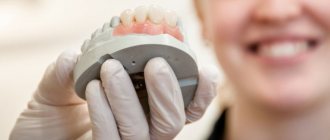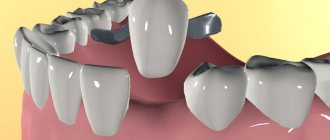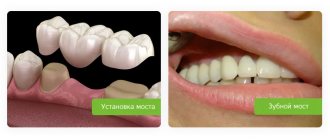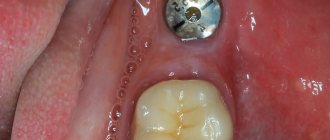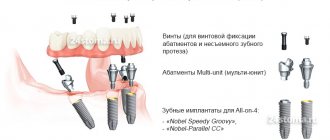In modern dentistry, there are many methods for restoring teeth. The choice of artificial material is huge, crown manufacturing technologies are improved every year.
The artificial structure is no different from real teeth.
In order to choose the right material, you should have the necessary information. Everything has certain properties, as well as a purpose.
Criterias of choice
The prosthetic method and material depend on the condition of your teeth. Only a dentist can provide this information after examining the oral cavity.
The main points that the doctor relies on when choosing a prosthetic method are the following:
- The condition of the mucous membrane in the oral cavity. In the case of periodontal disease, prosthetics are not recommended.
- How are the crowns positioned: is there crowding, reversal, etc.
- Is the root system stable?
- To what extent are the crowns destroyed? If units cannot be restored with composite materials, an anatomical inlay will be used to reconstruct the site of failure.
- What size and area does the defect occupy? In this case, a single crown, dental structures or implants can be used.
- Where is the area being restored? It is based on this indicator that the material for future crowns is selected.
You can hide some imperfections with veneers or lumineers.
The materials have been developed so successfully that dentists can restore teeth, taking into account all physiological characteristics. The price range varies and depends on many factors.
Interesting! Dental reconstruction is a recommendation and the final decision rests with the patient.
Crowns: what are they?
Depending on the composition they have indications and contraindications. Many people wonder how they are made and what they consist of dentures and their parts. Let's look at each type separately.
Metal
There are cast and stamped. They are widespread due to their low cost, as well as ease of implantation and maintenance, but have lost their relevance due to the use of more modern analogues.
They can be made of nickel, titanium, gold, silver, cobalt. The downside is complete unattractiveness.
Plastic
They are made with or without a finished frame. Attractive and beautiful design, together with simple and cheap installation, can make them leaders in application. Low strength and fragility are the main disadvantages of polymer dentures and structures. In addition, plastic is a highly allergenic component.
Used for restoration, correction of anterior incisors (low load) and temporary solutions, while a permanent option is in development.
Metal-ceramic
Metal base, in the upper layers of which a ceramic coating is applied. The most common: ideal price-quality ratio. Strength, durability, the ability to be inserted into any place are advantages. The disadvantages include a possible change in color over time (requires additional care and protection), may be rejected or lead to inflammation of the gums.
Porcelain
Porcelain implants are made using press casting followed by firing. Aesthetic, strong and durable, while completely anti-allergenic. However, the high price threshold greatly reduces the application.
Zirconium dioxide crowns
After smelting, they are able to completely copy the natural external structure of the teeth. The high cost and the impossibility of subsequent adjustments after smelting the structure make this material rare. However, high strength and durability are its advantages.
Materials for production
The correct choice of material determines how long the crowns will last and how correctly they will function. All modern materials differ from each other not only in cost, but also in physical properties.
An example of what artificial teeth look like
All properties allow you to install the prosthesis on a specific area. There are materials that are used only for the front teeth, and there are also those that can be used to restore only the chewing group.
Front row restoration material
The front teeth do not experience increased load, but crowns must meet all aesthetic requirements.
That is why it is recommended to use the following materials for reconstruction:
- Metal ceramics . This is a metal frame with several layers of ceramic on it. Increased wear resistance, long service life, aesthetic properties meet all requirements. The cost of such a design averages six thousand rubles.
- Porcelain. For manufacturing, pressing is used, this is what gives the products resistance to mechanical stress. Due to the absence of metal, the structure looks almost the same as a real tooth. Another main advantage of the product is hypoallergenicity. The metal is not strong enough, but the coating perfectly replaces a real crown.
- Plastic. This is one of the most short-lived materials, which can collapse even with minor impact. Due to the porous structure of the enamel, dyes from food penetrate inside, so the aesthetics of the crown quickly loses its appearance.
An example of work performed in a person's mouth
The patient decides which material to choose, because the cost differs significantly between them.
Material for crowns on chewing teeth
The load on these teeth is the greatest, which means that for restoration, materials that can withstand mechanical stress should be used. Metal-ceramics, which was described above, can also be included here.
An example of what ceramic crowns look like
In addition to this, there are other types, they are intended exclusively for these teeth:
- Zirconium dioxide. The material is no different from a natural tooth: transparency and color are transmitted with one hundred percent accuracy. It is possible to restore both the anterior and posterior dental rows. Abrasion resistance is high. Such qualities correspond to a high cost, which in some clinics can reach thirteen thousand rubles.
- Metal. The name of this material speaks for itself. To make crowns, only metal is used; there is no additional coating or spraying. The physical properties are high, everything is excellent for chewing teeth. Due to low aesthetics, it cannot be used on the front row.
- Metal composite. The material is not in demand. For manufacturing, a metal frame is taken, and several layers of plastic are applied on top. This design can only be used on chewing teeth and only temporarily. The thing is that there is no sufficient adhesion to the metal; with a slight impact, the product can fly off. As practice shows, crowns last for six months.
Example of metal-plastic crowns
To restore the entire dentition, combined structures can be used; they include crowns made of different materials.
Interesting! The combination of metals can be varied: ceramics with cermets or metal.
Conclusion.
The selection and application of artificial teeth based on information about both functional processes and functional patterns corresponding to nature is an absolute necessity - after all, who doesn’t want to live a full life, enjoy a great menu and a beautiful smile? (Fig. 30-32)
Rice. 30–32 Our goal is harmony between function and aesthetics. For the benefit of patients and, finally, ourselves, for motivation for the next correct restoration.
If you want to be happy, Give happiness to everyone around, Good, once done, Closes a full circle.
“Willst Du glücklich sein im Leben, trage bei zu anderer Glück, denn Freude, die wir geben, kehrt ins eigene Herz zurück”
(Johann Wolfgang Goethe)
How to restore your smile area
One of the difficult tasks is the restoration of the front teeth, because it must be solved as quickly as possible. It is recommended to use non-removable prosthetics. This is the only way to achieve increased stability of the crowns and get maximum benefits from use.
Dental restoration
All prosthetic methods aimed at restoration or compensation can be divided into several groups.
Color and shape
Lumineers or veneers are often used for these purposes. These are onlays, the shape of which matches the tooth, and the color is chosen by the patient. The surface may not be pre-ground.
Restoring part of a tooth
This method is used if part of the crown is destroyed by more than half. Artificial crowns are used; different materials are used for manufacturing.
First, part of the tooth is ground down, then a crown is installed. The disadvantage of this method is that during preparation it is necessary to remove most of the tooth.
Using the stump tab
Filling a gap in the dentition
To solve this problem, two methods can be used: installing implants or a bridge structure. The second option is considered the most budget-friendly, which is why it is in high demand. This is a group of crowns, attached to the supporting teeth, no grinding is needed.
With bridge prosthetics, a maximum of four teeth can be restored. All materials are suitable, with the exception of phosphorus.
Implants are used to restore incisors in the absence of a root. Thus, there is no need to touch adjacent teeth. When restoring the upper row, a sinus lift is used as an addition.
Example of clasp prosthetics
Interesting! When choosing a restoration method, it is recommended to take into account both the disadvantages and advantages, and not just the cost.
Varieties by type of fastening
Artificial restoration of the bite is completed after the installation of implants. Depending on the methods of fixation, the components used and the design, there are several types in the classification of dentures and dentures:
- spherical - convenient for using partially removable systems; two supports are enough to evenly distribute the load on the closed jaws;
- beam – screwing points for implants are determined (based on the force of pressure on the gums), a beam is fixed to the holders;
- clasp - installed on supporting organs using hooks;
- on implants - it is recommended to use metal retainers as opposed to cement when there are no contraindications;
- micro-locks – the main advantage is the ability to install locks on crowns and entire areas without preliminary grinding;
- suction cups - light and short-lived with a fairly cheap implementation.
Restoration of premolars and molars
When restoring chewing teeth, there are certain features: the structure must be resistant to any mechanical stress.
Most dentists recommend using the following methods for this:
- Implantation. When restoring the masticatory group, there are some disadvantages: the procedure is two-stage. The process takes a long time, but is popular. Bone grafting may be performed first.
- Clasp prosthesis. This is a base that looks like gum; crowns are subsequently installed on it. Recommended for use if there are no chewing teeth on both sides of the jaw. The main feature is that the load is distributed evenly; if other teeth have poor stability, this is important. But there are also disadvantages; if you want, you won’t be able to install ceramic crowns.
- Removable prosthesis. The option is considered one of the most budget-friendly. Nylon or acrylic dentures can be used.
Plastic crowns
As you can see, all recovery methods are different and have both disadvantages and advantages.
Which prostheses are best to choose?
Dentists can cope with tasks of any complexity. The choice of prosthetic method, material, approach to treatment, its duration and other nuances are determined only by the doctor.
According to indications
The main condition for determining approaches to therapy is the patient’s clinical condition. A professional will, first of all, focus on these conditions.
By price and budget
The second most important criterion. In dentistry, one problem can be solved in several ways. From those presented, the client can choose the option that is suitable in terms of cost, time and other criteria. This indicator also depends on what the dentures are made of.
By service life
The quality of the components used directly affects the wearing comfort and durability of the products. This factor should be taken into account when choosing an affordable option. The criterion must be on the same level as the price determination.
With complete or partial edentia
This criterion applies to diagnostics according to indications. Because the different conditions of the oral cavity and gums determine the possible destinations. A complete absence of masticatory organs requires one approach, a partial absence requires another.
On the upper or lower jaw
Different anatomical functions make adjustments to dental procedures. The doctor must take this factor into account when selecting a variety of suitable solutions.
Plastic or ceramics – which is better?
Many people ask this question, and it is not at all random. Most patients are captivated by the fact that the cost of plastic crowns is not high. Such crowns are installed even despite numerous shortcomings, but after a while disappointment sets in.
The advantages of plastic crowns are as follows:
- the cost is not high;
- no difficulties during installation;
- excellent imitation of natural crowns.
Example of teeth before and after restoration
The disadvantages include:
- the material is soft, it wears off quickly, the crown is destroyed;
- plastic has a porous structure, all paints from products are absorbed into it;
- Decay products penetrate into the intergingival space, as a result of which pathogenic microorganisms begin to multiply.
As you can see, this design has quite a lot of shortcomings; before installation, all of them must be taken into account. Now, as for ceramic crowns, they also have advantages and disadvantages.
The positive points include:
- the structure is dense, food dyes will not penetrate and will not change color;
- long service life;
- the ability to completely imitate the color of real teeth;
- does not wear out after time.
Zirconium crown
The only drawback of this design is the high cost.
Caring for the removable structure
People who have removable dentures must follow a number of rules. The thing is that the functioning of the product, as well as its service life, depends on this. At first, the sensations may be unusual. The process of taking it off and putting it on can cause some difficulties.
General rules for care are as follows:
- Remember that the prosthesis is fragile. It reacts positively to chewing loads, but as for impacts, this can cause damage. In this regard, the structure must be handled carefully.
- Remove the structure after eating and rinse under water. Solid particles may remain in the furrows and must be removed.
- Pay special attention to the part that is used for fixation. It is in contact with periodontal tissues, which means there should be no signs of dirt.
- After removing the denture, brush your existing teeth in your mouth.
- When carrying out any procedures with a prosthesis, be careful, as you can damage any part of it.
- Most of these structures should always be kept damp so they can maintain their shape. At night, place the prosthesis in a container with a solution or plain water.
The result pleases for a long time
Regardless of what material artificial teeth are made of, they must be carefully cared for. Due to severe contamination, an unpleasant odor will appear, which is almost impossible to get rid of. Don’t forget about a preventive trip to the hospital, because the structure should be examined by a professional.
Artificial onlays - what are microprostheses?
A description of the types of dental prosthetics with dentures can be found below in the text.
Tabs
They allow you to delay the installation of the crown. A standard procedure can save damaged teeth by placing one cap at the root and another over the gum. The resulting strong base can last quite a long time. The prosthesis is made of porcelain, metal, ceramics, zirconium and various composites.
Veneers
Thin plates are attached to the outside. Designed to hide blemishes, minor defects, and whiten.
Two manufacturing methods:
- Several layers are successively applied to the enamel.
- The veneer is poured (made) in a special mold and then secured in the mouth.
The quality and service life of the finished product directly depend on the components.
Lumineers
They are more similar to veneers, but there are a number of distinctive features:
- Much thinner.
- Follows contours and performs the function of enamel.
- Microcracks are completely eliminated.
- Serve up to 20 years.
- Removable design.
Eliminates cracks, whitens and hides minor defects.
Frequently asked questions to the doctor
Implant rejection
I heard that implants are rejected in most cases, is this true?
In fact, such a situation occurs. In rare cases, the body may not accept the implant. But still, as practice shows, in 95% of cases such surgical intervention is successful, and the person receives beautiful and straight teeth. Don’t be afraid, you just need to choose a good specialist and clinic.
Prosthetics
I would like to know why prosthetics are necessary?
Prosthetics are primarily necessary to ensure that chewing function is restored. First of all, this includes gastroenterological indications, because if the food is chopped poorly, the stomach will begin to work incorrectly.
Immediate
Replace a unilateral included defect. The design can be created from any materials used in dentistry. Capable of restoring a row of holes. Also found under the name "butterflies".
Several artificial crowns are attached to a miniature base, secured with hooks and locks. Recommended as a temporary solution after removal of diseased masticatory organs.
For those who are going to install metal ceramics and do not have enough money, it helps to gain time to collect them. Some patients use it all their lives, replacing it with a new one after a few years.
Classification:
By purpose:
- Restorative;
- Abutment (used in bridges ; they replace not only a defect within the coronal part of a tooth, but also a missing tooth or several teeth).
By design features:
- Full (cover the prepared stump from all sides), partial (three-quarter, half-crowns) leave the outer surface of the crown open;
- Telescopic (double; used in removable prosthetics, the first cone-shaped is fixed on the stump, the second, restoring the tooth, is part of the removable part and is put on the first).
According to the material used:
- Metal (noble or base alloys);
- Non-metallic (ceramics, zirconium dioxide, plastic, composite);
- Combined (metal-ceramics, metal-plastic).
By fixation method:
- Cemented (for prosthetics of natural teeth or on implants);
- Screw (used only for prosthetics on implants - artificial analogues of natural roots, strengthened inside the bone tissue of the jaws).
By service life:
- Permanent;
- Temporary - provisional (used at the stages of manufacturing the final ones to protect the stump from irritants, restore contacts with other teeth and for aesthetic purposes, including to form the contour of the gums ).
